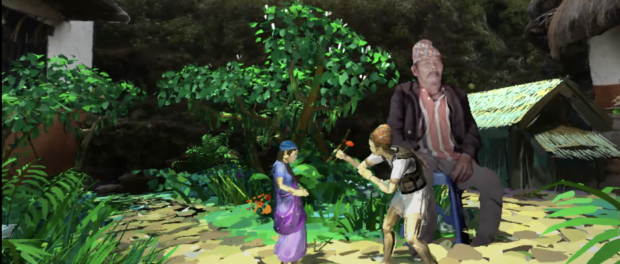10 Years of Phi : Five Moving Pieces
In 10 years worth of works that have ranged from film shorts to having a unique perfume made based on answers to a questionnaire, my best experiences at the Phi Centre have always been immersive VR works. When the visuals and audio respond to the viewer’s movements or voice, VR transforms from being a novel cinematic spectacle into a new blended reality. The five pieces on exhibition now — Heaven’s Gate by Marco Brambilla and Horizons VR works — include several immersive pieces, some outstanding storytelling, as well as a monumental conclusion to a four-part art work.

Starting with the piece that can best be described as an immersive digital art totem pole, Marco Brambilla’s Heaven’s Gate is the fourth and final piece in a work of that includes Evolution, Creation, and Civilization. In Heaven’s Gate, Brambilla uses clips from film to create a looping journey through seven extreme landscapes saturated with gif-like figures sampled from American cinema and pop culture. Imagine if Hieronymus Bosch animated the creatures in his paintings and then set a camera to pan from the bottom up. Brambilla says he developed the technique used to create the piece in 2006. It’s such a maximalist and more-is-more piece, that I wanted a second viewing after the first six minute ascension from a black pit of space to a series of overhead film studio lights. Spectral music changes to a gives way to a rhythmic beat as the viewer’s perspective ascends. Each of the seven levels has an animated icon cum idol at the centre and one wonders is this intended as an angel, a devil, a demon, a god? Look for King Kong, Leonardo DiCaprio raising a glass as the Wolf of Wall Street. The clips are balanced in a kind of radial symmetry, but there are minor differences on each side from the principal point of focus, so my attention was fully absorbed, if not overwhelmed. With colours and sound in constant upward motion, themes of spectacle’s bombastic nature such as empty consumption, the triumphs and failures of the American promise, viewers won’t miss the point. The title references this juxtaposition of external glamour with internal hollowness, coming from the film that bankrupted United Artists and changing the nature of the way America produced films.
After experiencing the piece in VR style, it’s reassuring and less demanding to watch it as a flat screen triptych in the next room. For those who are overwhelmed by the VR, the flat screen version is more graspable and it’s easier to catch details that were missed when immersed within the tube of imagery. Yes, that is Donald Trump screaming at Abe Lincoln.

As for the second exhibition, every time I go to the Phi Centre, I say, “That was the best VR I’ve ever seen.” Are artists just getting better at the immersive medium or are the artists getting better at telling stories that that mean something to me? When knit together — an immersive experience with strong storytelling — the result is impactful and enriching. The four works of Horizons VR focus on the stories of individuals who experience life at extremes. Each has a strong emotional punch. Reeducated by Sam Wolson comes from the New Yorker’s VR documentary series and puts the viewer in the cell with three detainees of China’s Xinjiang’s “reeducation” camps for Uyghurs (and other Muslim minorities). As the men recount their experience, objects appear and the viewer must spin round to see the appearance of the window, the bunkbeds, the toilet. The mostly greyscale colour scheme gives documentary importance to the painful reality the men faced.
Using the similar technique of making the viewer turn to face the action, Marco & Polo Go Round by Benjamin Steiger Levine puts the viewer in the kitchen of a couple on the brink of capsizing on the morning of Marco’s birthday. The backstory unfolds as the environment around the couple changes. Just as surreal events surprise Marco, they surprise the viewer as well.
Part animation, the film Goliath: Playing with Reality by May Abdalla and Barry Gene Murphy is about the experience of DJ and online gamer Goliath when he first encounters schizophrenia and what his life is like before, during, and after his hospitalization. Stereotypes about schizophrenia are addressed, as are the complicated side-effects of medication. Goliath eventually finds a kind of stability and meaningful connection to others through Twitch and online gaming. Enmeshed in Goliath’s narration are opportunities for the viewer to interact, whether that is shooting trolls and friends or listening in on abstractly represented thought patterns.
Finally, my favourite of all, Kusunda by Felix Gaedtke and Gayatri Parameswaran is a deeply moving work about the nearly extinct indigenous Nepali Kusunda language. The viewer is brought to the Himalayas to meet some of its remaining speakers, including a woman who teaches the young generation, a once-hunter-gatherer shaman, and his brilliant granddaughter, Hima. So many things align perfectly here in this transportive piece — the people, stories, the animation, the live environment capture, and especially the opportunity to speak the Kusunda language. I felt very emotional at the end of this piece, knowing that I too am now one of the few people in the world who have spoken Kusunda and the directors make it clear that this is part of the intent. This film is a lifeline to precarious cultural traditions in the face of modernization. Through this very touching piece of VR, some of the most contemporary technology of all is, has given a platform to the linguistic crisis and allows it to find new speakers who will grow it. Do not miss this work.
Heaven’s Gate and Horizons VR are at the Phi Centre form June 30 to October 24. Tickets and info can be found HERE.






